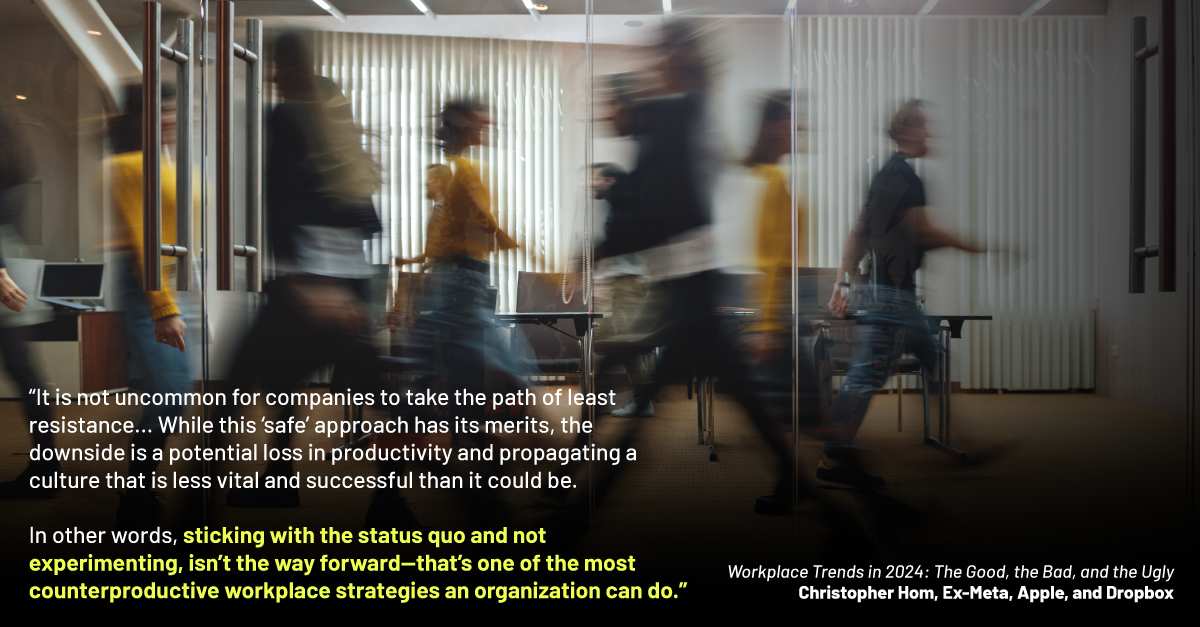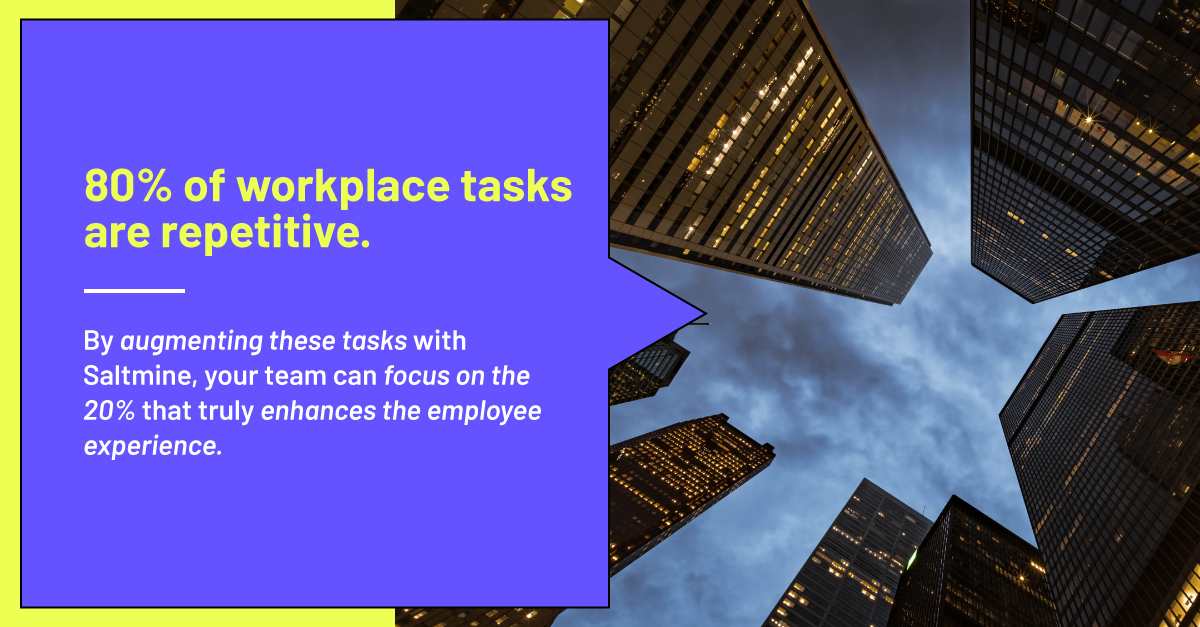Industry experts agree: the workplace and CRE sector is slow to embrace change and new technologies. A digital transformation is essential to harness AI’s power, streamline workflows, and foster innovation, ensuring organizations stay competitive in an evolving market.
Part of my job as a marketer in the world of workplace and corporate real estate (CRE) is to talk to industry thought leaders and innovators. And if there is one common perspective that is shared amongst the various experts I’ve spoken to and collaborated with, it is this:
The workplace and CRE industry is slow-moving, often adverse to change, and seldom accepts new technologies.
The prevailing mindset is “if it’s not broken, don’t fix it,” and until the industry changes its thinking and approach, digital transformation won’t occur.
As our own CEO, who has decades of experience in architecture and design, has said, “the industry is late to the party and has never fully digitally transformed,” like most industries that have eliminated antiquated manual processes and monotonous tasks with technology.
That said, as ChatGPT and other AI tools have flooded the zeitgeist of nearly every industry—“shiny new toy” syndrome is rampant across CRE despite its hesitation in integrating new and emerging technologies. It’s ironic, but amidst holding onto legacy systems and heavy reliance on third parties, many in the industry expect any new tech to have AI capabilities.
The problem is many folks don’t know why. Or if they do know what specific tasks they want to be automated, they don’t have smart data to fuel the AI engine.
Take test fitting for example. Many workplace and CRE professionals want to automate this process, and for good reason—it’s a tedious and lengthy manual task often outsourced to costly third parties. Test fitting can be done 85% faster with the right tech, but if you’re still using static excel spreadsheets for programming or your workplace guidelines are in PDFs, automated test fitting can’t help you.
Like a sports car needs high viscosity oil to ensure the engine is performing at its most optimal level, sophisticated AI engines need high-quality, intelligent data to learn and make decisions. Without this, AI will struggle to understand complex patterns, make accurate predictions, and generate meaningful insights. In other words, before you can leverage AI, your data, tech stack, processes, and workflows must be totally digitally transformed.
Digital transformation is the first step
As mentioned, the dichotomy is that people want to harness AI’s power, but without a digitally transformed infrastructure, AI can’t support them.
Digital transformation is the foundational step towards unleashing the full potential of AI in workplace and CRE. Challenging the status quo in an industry riddled with legacy systems and fragmented processes is the only way forward.

In other words, if we don’t step outside the box to transform the manual and siloed processes used in CRE with smart tech, we can’t expect to tackle the current issues facing the modern workplace.
Data and workflows
In our digital-first world, data reigns as the supreme leader of why or why not things get done. From workplace programming to scenario planning, the quality and accessibility of data determine the effectiveness of decision-making processes.
For example, liberating pre-design tasks from the constraints of legacy systems allows workplace organizations to ensure that their data is not only accurate but also readily available for analysis and utilization.
If you’re using legacy systems, chances are they aren’t able to talk to each other very well, which means you probably outsource many tasks to third-party contractors. To engage in digital transformation, organizations need to assess everything from consultants and systems to their entire tech stack to complete the CRE project.
Moreover, streamlining workflows and processes is essential to eliminate the curse of siloed systems. Take communication and collaboration, for example.
Communication and collaboration
The push/pull means of communication and collaboration are incredibly ineffective when it comes to capital projects, creating many challenges.
Firstly, there’s the tiresome back-and-forth of synchronous feedback, where the latest revisions often get lost. This issue also affects workplace guidelines and space programming, typically stored in PDF documents. It’s easy for the master PDF to end up on someone’s desktop who then leaves the company, making it difficult to track the latest version.
There’s also the lack of contextual understanding for those without a design background who are expected to interpret rendering images. Or consider test fitting—a process that typically involves extensive back-and-forth and often requires a contractor, despite the availability of technologies that can significantly reduce timelines.
These manual processes don’t belong in our digitally transformed world. Inefficient communication and disjointed workflows hinder productivity and innovation. By leveraging integrated systems that facilitate seamless collaboration and information sharing, organizations can break down silos and foster a culture of agility and innovation.

Asynchronous collaboration represents a paradigm shift in how stakeholders engage and align with one another. Traditional methods often involve time-consuming meetings, design formats lacking contextual visuals, and endless email exchanges, leading to delays and miscommunications. By embracing asynchronous collaboration tools and platforms, organizations can facilitate real-time communication and collaboration, enabling stakeholders to stay aligned and responsive to evolving needs and priorities.
Data integration and governance
Data integration is another critical aspect of digital transformation. Too often, valuable data is segregated across disparate systems or entrusted to third parties, limiting organizations’ ability to harness its full potential. By taking ownership of their data and implementing robust integration strategies, workplace teams can ensure that their data is not only centralized but also accessible for informed decision-making.
We need to put a high emphasis on data quality. As workplace strategy expert Kevin Sauer said in a recent blog, “As the saying goes, ‘garbage in, garbage out.’” AI is only as good as what you put into it, so you have to collect a variety of data points. If you don’t have a way to sift through the “garbage” data, you can also use AI for that.

You can augment these tasks with AI, but you have to have the right tools in place, and those tools must be digitally transformed or leverage AI to some degree. Many tasks in CRE, like space programming or test-fitting, are incredibly repeatable; AI should augment them.
That way, the workplace team is freed up to focus on the 20% of the project about the experience, instead of the mundane tasks that AI could do better.
Conclusion
AI is neither a silver bullet nor a total replacement for humans. It is a supplemental tool that augments and automates manual, tedious tasks and processes, allowing workplace and CRE teams to be more efficient and agile, promising speed and enhancement. This enables them to focus on measuring the effectiveness of their real estate portfolios. AI helps teams significantly reduce errors and empowers them to be more creative in solving the challenges of our dynamic workplace landscape.
But first must come a total digital transformation of legacy systems and partnerships. Digital transformation serves as the cornerstone for unlocking the transformative power of AI in the workplace and CRE sector.
By embracing data-driven decision-making, streamlining workflows, integrating data, and fostering asynchronous collaboration, organizations can lay the groundwork for AI adoption and drive innovation and growth in an increasingly competitive landscape.
The time to embark on the digital transformation journey is now, as those who fail to adapt risk falling behind in an ever-evolving market.
For more on augmenting the manual processes of workplace design and strategy, check out this blog post.
Enjoying our blog? Be sure to subscribe to stay up-to-date on Saltmine's original content with the form below!


